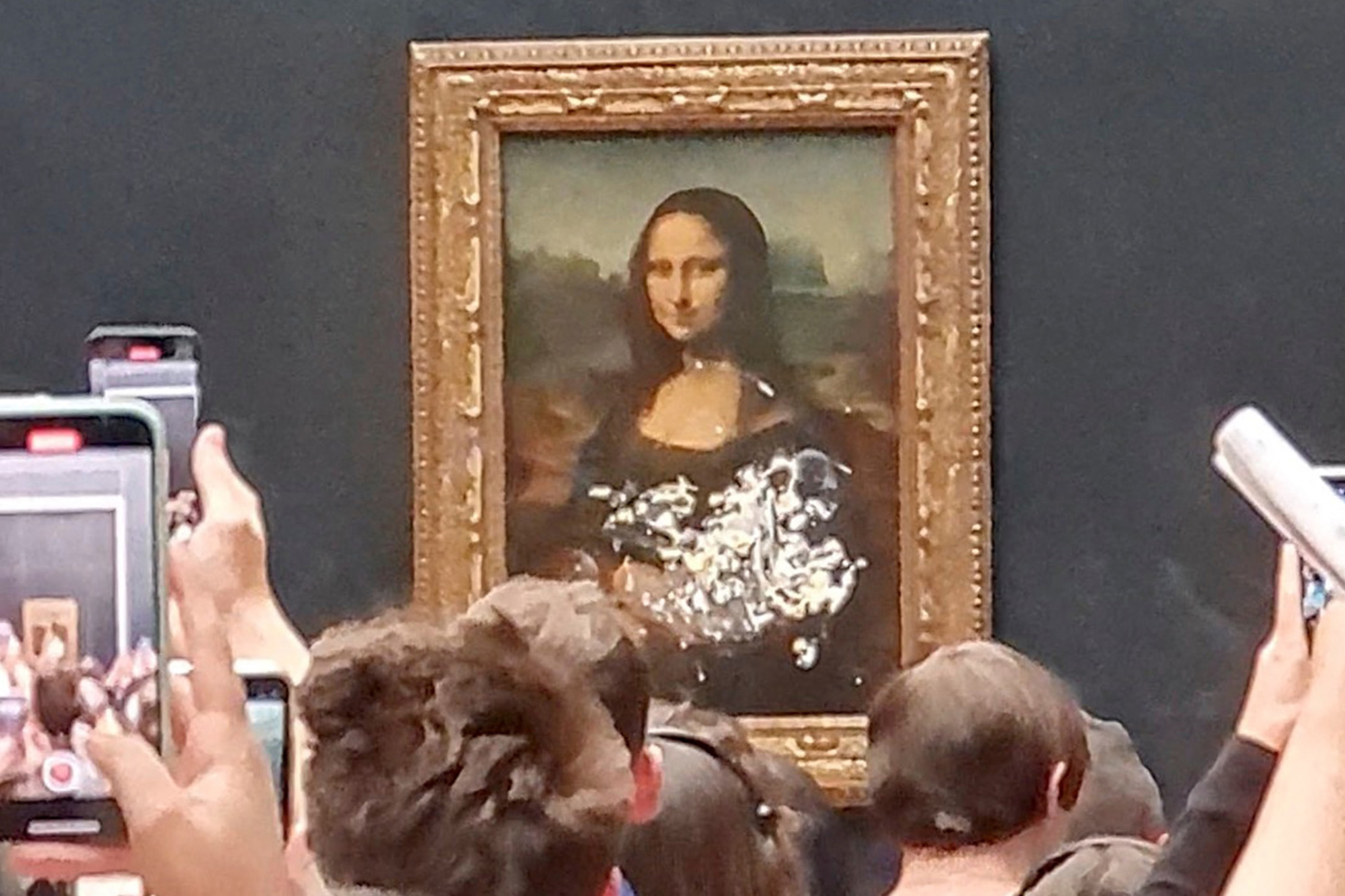Climate and Art

CLIMATE ACTIVISTS ATTACK THE ARTWORKS:
VANDALITY OR AWARENESS?
Climate activists and their actions are on the agenda again. The reason is that they carry out their actions with a perception of action that is thought to be social. The medium that climate activists choose as a form of expression is works of art. This makes everything more interesting. Although these actions were carried out to raise awareness, it is controversial that they resonate as vandalism rather than raising awareness in society. So, is this unfair to works of art or is it an appropriate action?
Greta Thunberg’s impact on the climate crisis
Before talking about the cause and effect relationship of this attack on art, we need to recognise a name that may be at the source of all this: Greta Thunberg. Thunberg is a Swedish climate activist born in 2003. She has been seriously interested in climate issues since she was 8 years old. When she was 11 years old, she fell into a severe depression and stopped speaking and going to school. She is diagnosed with Asperger syndrome, a type of autism. Thunberg has been actively participating in protests since the age of 15. In the summer of 2018, Thunberg begins her protests by organising the first “School Strike for Climate” in front of the Swedish parliament. Although Thunberg’s father is uncomfortable with the whole process, he says his daughter is happy.
Thunberg ended the climate strikes at school in the summer of 2023, yet the protests continue unabated. Climate activists continue their actions with the inspiration Thunberg provides.
What do activists think?
These actions taken by climate activists under the “Just Stop Oil” protest are a movement originating from Britain. Just Stop Oil, a civil resistance effort to get the British government to commit to stopping new fossil fuel production, directly targets museums and paintings.
Why are the artworks targeted?
Of course, a sociological evaluation can be made on this issue. Art historian Prof. Dr. Esma İgüs says that museums are places where governments represent themselves. She states that the purpose of museums is to bring humanity together on a common ground with the ethnographic, archaeological or artistic works they contain. This is exactly why we see that it is not a coincidence that climate activists choose these places as propaganda venues.
In other words, climate activists also underline the connection between works of art and the existence of humanity: If there are humans, there are also works of art. When humanity disappears due to the climate crisis, works of art will no longer be possible to create. It is a fact that the climate crisis constitutes the source of life. Climate activists have a target-oriented form of expression, as actions against works by artists such as Da Vinci, Picasso, van Gogh, and John Constable will of course attract much more attention than attacks on any ordinary place or work.

What has been done to which works so far?
Climate activists targeting the most iconic paintings of museums carried out their actions by pouring soup and throwing cakes on the paintings, as well as by sticking their hands to the paintings to protest.
The protests continued and continue despite the museums issuing a joint statement that responsible activists seriously underestimated the fragility of these irreplaceable objects that should be preserved as part of our world cultural heritage.
In the protests that intensified in 2022, a cake was thrown at Leonardo da Vinci’s “Mona Lisa” painting in the Louvre Museum in Paris. Mona Lisa recently got its share again of soup being spilled on her.
At the Vincent van Gogh exhibition at the Courtauld Gallery in London, they glued their hands to the frame of van Gogh’s 1889 painting “Blooming Peach Trees”.
Two climate activists, members of Just Stop Oil, glued their hands to the frame of John Constable’s “The Hay Wain”, which is also exhibited at the National Gallery in London.
Five climate activists who came to the Royal Academy in London glued their hands to the frame of the painting, which is a copy of the “Last Supper”, believed to have been painted by Leonardo da Vinci’s student Giampietrino in the 1520s.
Two members of the activist group “Extinction Rebellion” in Melbourne, Australia, glued their hands to the work “Massacre in Korea” by Pablo Picasso, exhibited at the National Gallery of Victoria.
Also in London, two members of the environmental group “Just Stop Oil” threw tomato soup at the painting “Sunflowers” by Vincent van Gogh, exhibited at the National Gallery.
Two activists, members of the environmental group Letzte Generation in Germany, threw mashed potatoes on the work of French painter Claude Monet called “Les Mueles” (The Grain Pile) at the Barberini Museum in Potsdam.
In Florence, Italy, climate activists glued their hands to the painting “Primavera” by Renaissance painter Sandro Botticelli to protest the use of fossil fuels.
The protests continued in 2023. Two activists from the group Just Stop Oil attacked Velázquez’s “Toilet of Venus”, also known as the “Venus of Rokeby”, with small hammers. That’s not all that happened to this painting. This oil painting was damaged by an activist defending women’s right to vote in 1914. Women’s rights campaigner Mary Richardson was targeted in protest at the imprisonment of women’s rights activist Emmeline Pankhurst. The reason why the painting is targeted again today is actually linked to the past. In the painting, naked Venus, the goddess of love, is depicted lying on a bed, her back turned to the viewer, and her son Cupid is holding a mirror to her face…
We all know what happened to Mona Lisa recently. Activists spilled soup on the painting and then asked: “Which is more important: Art, or the right to a healthy and sustainable life?” they asked.

Art or life?
Comparative questions such as whether art or life is more valuable are on the agenda of climate activists and environmentalists. The answer to this question is, of course, life. Still, why do we have to ask this question?
Activists take all these actions while leaving behind unexamined questions, including why art and everything else are pitted against life in debates about Earth’s habitability. Why do the actions against all these works of art provoke such a loud response from both those who oppose these demonstrations and those who support them?
Let’s go back to the questions we can answer: Is the selection of works intentional? Yes. Van Gogh, Klimt, Monet, Vermeer, Constable, da Vinci… These names are part of the sacred canon of art. It is the art itself that is sold for high prices at auctions. The activists’ idea is to send a message through this art to those who bring the world to the brink of disaster. The reason they do this in museums and art institutions, which will attract a lot of reaction, is that these large cultural institutions often benefit from the patronage of the oil industry.
Are the works really damaged?
The common statement of the museums is that destroying works of art only harms the common heritage and causes anger among the masses. There is a direct attack on the works, for sure. But most of the paintings are protected by a bulletproof glass frame. In this sense, no direct damage is done to the works, yet the action is a direct act of raising awareness by showing the purpose of the damage. For this reason, all these art attacks to draw attention to the climate crisis actually bring another question to mind: What happens to activism when these actions resemble a performance, that is, art itself? Does it deviate from its purpose?
Are these protests a useful form of expression?
It’s definitely a form of expression. But this is a matter of debate in society. Some see this as vandalism, and some see it as an act of awareness… Environmentalists say, “Do we show the same care to protect the Earth as we do to protect the common heritage of humanity?”
It is undoubtedly a fact that our planet is on the verge of a climate crisis and we need to do something for our nature. However, artists and art historians are divided into two. Some support it, some do not find it right.
So should we draw attention to the climate issue in this way? Is there another solution?
Nazperi YILMAZ
Etiket:activists, aktivist, art, climate, climate activists, climate changes, da vinci, dilko social, Esma İgüs, iklim aktivsitleri, ilklim, Picasso, sosyoloji, tablo, Van Gogh, vandal



